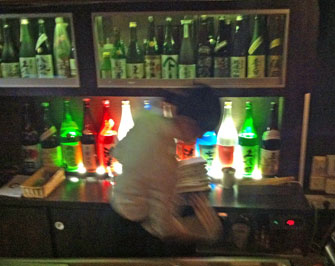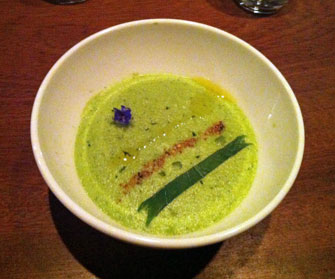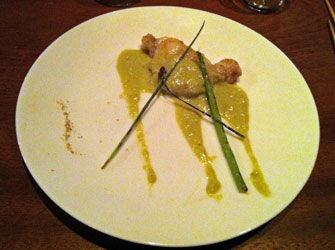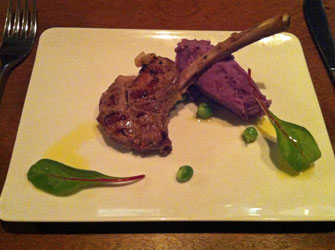
Note: Chef Victor Magsaysay has moved to the restaurant Ito, but his former assistant carries on in the same vein at Sakebar. Dec. 4, 2013
Paris’s hottest new restaurant (according to some of my informants) turns out not to be new at all, but it is still hot. While Sakebar has been around for several years, it was called Youlin until last year, when its eponymous one-named owner took on a new partner. In the meantime, Youlin’s other restaurant, Sola, which had been increasingly attracting attention on the restaurant grapevine, won its first Michelin star in March.
The buzz about Sakebar also started about the time that its current chef, Victor Magsaysay, took over the kitchen at the beginning of the year. Like its more expensive relative Sola, Sakebar serves creative French food with an Asian twist.
The cozy little restaurant with a low wooden bar seats only about 20. My friend Bonnie and I sat at the end of the bar where we could watch through a window as the chef and his assistant, bandannas knotted around their heads, worked away in the kitchen, and where we could chat with Hana, the bright, friendly, trilingual (French, Japanese, English) young woman who runs the place, and the sweet young Japanese waitress who told us she was about to move back to her country.
The deal here is that there is one set “Omakase” menu (€35) consisting of five small dishes, with no choices (although dislikes and allergies are accommodated) and not including dessert. It changes from season to season and with the inspiration of the chef. We had the spring menu and opted for the sake tasting menu, which costs €30 more per person for a different glass of sake with each course (the restaurant stocks over 30 varieties of the rice wine).
We started this adventure with a plate of amuses bouches: little tidbits, just enough to pique the appetite, including sake-marinated salmon roe on slices of pickled turnip, enoki

mushrooms in miso mustard sauce wrapped in spring leeks, and sweet squid with sanshō (Japanese pepper) on a bed of wakame.
With each course, Hana came over to serve us a glass of sake and tell us about its qualities and even the meaning of its name. The first one, whose name translates as “drop of the mountain,” was light and fruity. As the evening progressed, we tasted two milky, unfiltered sakes, some that were drier or sweeter, and one very light one (around 10 percent alcohol, as opposed to around 14 percent for most) with dessert. We also learned that the type of rice used, where it is grown and the extent to which the rice is polished all affect the characteristics of the sake, just as the grape variety, terroir and winemaking techniques affect the characteristics of wine.
The next course was a refreshing, foamy

zucchini gazpacho, its subtle flavor enlivened with a sprinkling of hot pepper. Perfect for spring or summer.
Next up was a terrific risotto made with three types of carrots, dulse (red alga), dashi (Japanese stock, which gave it a slightly smoky flavor) and a hint of cream. Victor pointed

out that no salt was added to this rich, perfectly cooked dish, since the dulse provides just the right tang. It was followed by a piece of lotte

(monkfish) in a delicate sauce made with cream, estragon and sake. The meat course was an exquisite lamb chop served with a delicious purple yam (called “ube” in the Philippines) mashed with rosemary oil, which was

wonderfully and strangely enhanced by the few fresh peas that accompanied it on the plate.
Intoxicated by the sake, we went all out and had the dessert: variations on sesame, with a dollop of excellent black-sesame ice cream and white sesame foam, and a combawa (kaffir lime) and black-sesame tofu cake. Rich and light at the same time, it was not too sweet and finished the meal on just the right note.
By the way, wine and Champagne are available for those who don’t appreciate sake, but part of the enjoyment of eating at Sakebar – besides the great food and friendly ambiance – was tasting all those different sakes. Arigatou, Youlin, Victor and Hana. Next stop: Sola.
Favorite